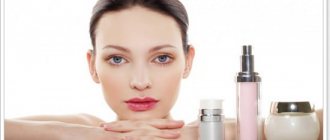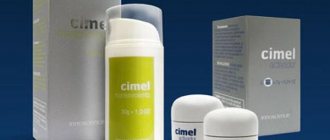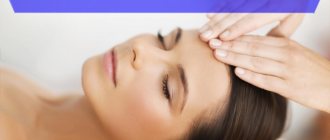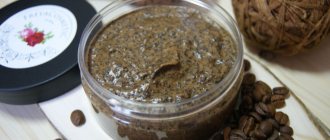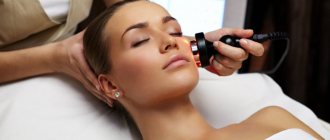Chemical peeling for the face - what is it?
Chemical peeling for face
is a cosmetic procedure aimed at improving the quality of the skin.
The word “peeling” comes from the English “to peel” - “to cleanse”, “to remove the skin”. This is in fact with the aim of improving its appearance and general condition. Chemical facial peeling occupies a special place among various peelings.
. With this peeling, it is not mechanical exfoliation that does not exclude a violation of the integrity of the skin, but the dissolution of dead cells of the surface layer of the skin upon contact with the peeling components. As a rule, the active components of chemical peeling are organic acids.
Chemical peels: pros and cons, possible consequences
After the procedure, the following are normally observed:
- excessive skin tightness;
- redness;
- peeling;
- swelling;
- discomfort, tingling and burning;
- temporary tendency to pigmentation.
Allergy to the components of the composition and exacerbation of dermatological diseases are possible. If the protocol is not followed, the cosmetologist is inexperienced and has low qualifications, scars may form. The time for chemical peels is the period of low solar activity from October to April.
Types of chemical peels by depth of effect
• Superficial peeling
has an effect within several layers of keratinized cells of the epidermis. It is the most gentle type of chemical peeling. After it, you can continue your normal lifestyle. Mainly recommended for young problem skin. The effect does not last long; repeated courses are required.
• Medium peeling
affects the entire stratum corneum of the epidermis to the basement membrane. After this peeling, home treatment is required for a week, as the face remains hyperemic and fine- or large-plate peeling occurs. It is carried out to solve specific problems, as well as to combat age-related changes in the skin. The effect lasts a long time, repeated courses only after a year.
• Deep chemical peeling
– rejection of the epidermis affecting the basement membrane. The procedure is quite responsible and carried out under anesthesia, since it is nothing more than a chemical burn of the facial skin followed by regeneration of the epidermis. It is performed in a hospital and is aimed at removing deep wrinkles and scars. The effect lasts for a very long time, up to several years, but can be done only once; the rehabilitation period lasts about 5 months.
Recovery after peeling
The recovery period after superficial peeling will last 2-3 days, after medium peeling - 5-14 days, after deep peeling it can last from a month to six months.
The main task of post-peeling recovery is to reduce discomfort, preventive procedures to prevent side effects, as well as all kinds of complications, stimulate the regenerative process, protect the skin, antioxidant and anti-inflammatory therapy.
After the peeling procedure, you need to use restorative cream and serum with hyaluronic acid for 2-3 days. It is important to note that creams must contain sunscreen filters of at least SPF30.
Main objectives of chemical peeling
1. Exfoliation (peeling) of keratinized cells of the epidermis leading to proliferation (reproduction) of cells of the basal layer, that is, to the renewal of the entire skin.
2. Elimination of skin imperfections and problems as a result of exfoliation and thanks to the specific properties of acids.
3. Mobilization of the protective and regenerative functions of the skin due to the stress action of acids.
Skin before and after chemical peeling
Why do you need a chemical peel?
Chemical peeling is often the procedure of choice when correcting cosmetic defects of the skin of the face and other parts of the body. As a result, patients receive:
• Improving the appearance of the skin – it becomes smoother, softer, and has an even color
• Disappearance of age spots, effects of acne, scars and stretch marks
• Normalizes skin pH and sebaceous gland function
• Rejuvenation of facial skin by smoothing wrinkles, increasing skin firmness and elasticity due to increased collagen synthesis
• Good mood and increased self-esteem
Operating principle
The principle of chemical peeling of the skin consists in targeted damage (chemical burn) to the layers of the epidermis, for which concentrated acids or alkali are used. To restore tissue, the body activates skin regeneration, the synthesis of collagen and elastin, building new layers, firm and elastic. Renewed skin after chemical peeling is devoid of barriers to normal breathing and full absorption of nutritional components from skincare products. This has a positive effect on her future condition.
Please note that a feature of chemical peeling is pronounced peeling of the skin and redness of the face. These are side effects of the procedure. With proper care, they go away without complications or residual marks.
Indications and contraindications
Indications for chemical peeling
Indications for chemical peeling
1. Problem skin (post-acne, acne, comedones) 2. Presence of hyperpigmentation 3. Skin with low tone, not elastic, flabby 4. Age-related changes in the skin 5. Photoaging (skin exposed to excessive UV radiation) 6. Presence of scars and ingrown hairs 7. Oily skin with enlarged pores 8. Thickening of the stratum corneum of the skin, which makes it uneven 9. Dull skin color 10. Preparatory stage before more serious and deep cosmetic procedures.
Indications for chemical peeling by age
1. Adolescent age from 14 years as prescribed by a doctor according to indications.
2. 25-30 years for acne, post-acne, hyperpigmentation, photoaging, to prevent skin aging.
3. 35 and older age groups for the purpose of prevention and treatment of cosmetic skin defects and as preparation for other cosmetic operations.
Contraindications for chemical peeling
Absolute contraindications for chemical peeling:
1. Any chronic diseases in the acute stage 2. Colds 3. Pregnancy and lactation 4. Tendency to form hypertrophic and keloid scars 5. The need for radiotherapy 6. Fresh tan 7. Recently (less than 8 weeks ago) traumatic procedures ( deep cleansing, mesotherapy, laser resurfacing) 8. Mental illnesses 9. Individual intolerance to individual peeling ingredients 10. Taking immunosuppressants, retinoids, drugs with a photosensitizing effect 11. Severe rosacea 12. Oncological diseases 13. IV–VI skin phototypes determined by Fitzpatrick 14. Skin diseases (eczema, allergic dermatoses, atopic dermatitis, psoriasis, etc.) in the acute stage 15. Infectious skin diseases (viral, bacterial, fungal) 16. Violation of the integrity of the skin, injuries in the area of peeling 17. Poor wound healing 18. Diabetes mellitus and hypertension
Relative contraindications for chemical peeling:
1. Multiple nevi 2. Hypertrichosis 3. Increased skin sensitivity 4. Patient age less than 18 years 5. Menstruation
Mechanism of action of acid peeling
1. Damage to the epidermis (chemical burn).
2. In response, skin cells begin to intensively produce inflammatory mediators, signaling molecules, and enzyme growth factors.
3. The mitotic activity of basal cells increases (cells are actively renewed).
4. New vessels are formed and the production of fibroblasts is activated, leading to the synthesis of new collagen, elastin, glycosaminoglycans and enzymes.
5. The dermis is compacted and thickened and all layers of the skin are moisturized.
The structure of the skin
Knowledge of the anatomy and physiology of the skin is necessary to understand the mechanism of action of certain cosmetic procedures.
Leather
is not just a shell covering the human body. This is a full-fledged organ that performs a number of specific functions and has a complex structure. The mass of the entire skin is approximately 5% of body mass. There are approximately 5 million hairs on the surface of human skin. For every square centimeter of human skin there are on average 100 pores and 200 receptors.
Complete renewal of young skin occurs in 28 days; with age, this process slows down every year, and the stratum corneum will thicken and become uneven. And also the thickness of the stratum corneum can thicken under the influence of ultraviolet rays.
Human skin has a constant pH of 3.5-5.6, if it shifts too much, skin problems such as rashes or irritations may occur. pH up to 3.5 (acidic environment) is typical for dry skin, pH greater than 5.6 (slightly acidic environment) - for oily skin. There can also be mixed skin, when the skin type is different in individual areas. And therefore, in order to choose the right cosmetics, you need to know your skin type.
The structure of the skin is divided into three main layers - the epidermis (the surface layer of the skin), the dermis, or the skin itself, and the subcutaneous fatty tissue (hypodermis). Each of these three layers has its own layers, appendages and elements.
The most significant layer of skin in cosmetology is the epidermis. Its structure is multilayered. The epidermis produces the pigment melanin, the amount of which determines the color of the skin and its intensity.
Fat-soluble substances, unlike aqueous solutions, penetrate well into the epidermis, since cell membranes contain a large amount of fat and these substances seem to “dissolve” in the cell membranes. There are no blood vessels in the epidermis; its nutrition occurs due to the diffusion of tissue fluid from the underlying layer of the dermis.
The basis of the epidermis is the basement membrane, the germinal layer of intensively multiplying cells that replace those that die and slough off every day.
Above the basal layer is the spinous layer, the cells of which have spine-shaped processes. It is here, in the intercellular space, that lymph circulates, providing nutrition and metabolism in the cells of the epidermis.
Above the stratum spinosum, the granular, shiny and horny (uppermost) layers of the epidermis are successively located.
Epidermal cells
1. Keratinocytes
- these are the cells of the spinous, basal and granular layers; they are in constant motion. They are formed due to the division of germ cells of the basement membrane located at the border of the epidermis and dermis. They mature and move from the lower layers to the upper ones (from the spinous layer to the granular layer), during which time keratin (a very strong protein) accumulates in keratinocytes.
2. Corneocytes
are formed at the end of the life of keratinocytes and are a cell without a nucleus and main organelles, something like a “bag” filled with keratin. Corneocytes are dead cells that form the stratum corneum and are flat scales. They perform the barrier function of the epidermis.
Corneocytes move further upward, and when they reach the surface of the skin, they peel off and new ones take their place. Corneocyte renewal occurs on average within three weeks.
Corneocytes are held together by a special substance, which consists of a double layer of special lipids - ceramides (ceramides). Ceramides (ceramides) molecules have hydrophilic “heads” (water-loving fragments) and lipophilic “tails” (fat-loving fragments).
3. Melanocytes
- these are cells that are located on the basement membrane among the germinal layer of the epithelium; these cells produce melanin. This pigment performs a protective function and protects a person from infrared radiation and partially ultraviolet radiation. Also, the color of the skin depends on the saturation of melanin. In some cases, the formation of age spots depends on the condition of the basement membrane.
4. Langerhans cells
, which perform a protective function against foreign bodies and microbes.
5. Merkel cells
- These are tactile cells that are found in the basal layer of the epidermis. They effect skin sensitivity. Most of them are in the skin of the fingertips, on the tip of the nose and erogenous zones.
Beneath the basement membrane is the skin itself, or dermis. It contains the papillary and reticular layers. The papillary layer borders the epidermis. The papillary pattern on the palms and feet is nothing more than papillae of the dermis visible through the epidermis. Below is the reticular layer, which contains sebaceous and sweat glands, hair follicles, nerve endings (skin receptors), as well as collagen and elastic fibers.
The elasticity and strength of the skin directly depend on the presence of elastic fibers and the amount of collagen in the dermis.
The subcutaneous fat layer is located under the reticular layer of the dermis and performs shock-absorbing and warming functions.
The mechanism of action of acids on the skin
Organic acids are used for chemical peels. For the superficial - fruit, for the middle - trichloroacetic (TCA), for deep - phenolic and trichloroacetic of higher concentration.
Acid, when exposed to the skin, depending on the concentration and exposure, dissolves the keratinized cells of the upper layers of the epidermis, and sometimes the entire epidermis, down to the basement membrane.
In other words, when applying the peeling mixture, we receive a controlled chemical burn to the skin of the face. Unlike a traumatic burn, here the depth of acid exposure is clearly controlled by a cosmetologist - this allows us to solve exactly those problems of the patient that brought him to the cosmetology clinic.
Fruit and some other acids have an exfoliating effect, which is achieved by weakening the adhesion (cohesion) of corneocytes in the stratum corneum. In response to increased peeling, active division of cells in the basal layer is triggered.
They also have a moisturizing effect on the skin as a result of accelerated renewal of the epidermis, since on the surface of keratinocytes there is a complex of hygroscopic molecules, or the natural moisturizing factor NMF. This factor is found in greater quantities in young cells.
Chemical acids have a stimulating effect on skin fibroblasts and thereby promote the synthesis of glycosaminoglycans and collagen.
The stress theory also explains the increased synthesis of the intercellular substance of the dermis. In response to stress, the skin's protective systems are activated. The skin is mobilized, the reparative activity of skin cells is enhanced, and the synthesis of vital molecules is accelerated.
The result will be a thinning of the epidermis and a thickening of the dermis layer. The surface skin becomes firmer and more elastic, and small wrinkles are smoothed out. Acids normalize lipid balance, cleanse the ducts of the sebaceous glands, thereby reducing oily skin and preventing the appearance of comedones and acne.
By exfoliating dead epidermal cells, a whitening effect is achieved. Plus, some acids act on the production of melanin, and thereby also help lighten the skin.
After the procedure
After the peeling procedure has been completed, the following rules must be adhered to during the recovery period:
- Protect your skin from direct sunlight by using special sunscreens
- Do not visit baths, saunas, or expose your skin to other thermal effects.
- Limit visits to gyms, fitness clubs, swimming pools and other sports facilities
The results of the peeling procedure are visible immediately. Thanks to the launch of skin renewal mechanisms, the active production of collagen begins, which makes the skin surface firm and elastic, and the overall tone of the face improves.
Possible risks and complications associated with the peeling procedure:
- Skin redness
- The occurrence of skin swelling
- Increased level of pigmentation in the peeling area
Stages of chemical peeling
1. Pre-peeling preparation.
Purpose: adaptation of the skin to acid and leveling of the top layer for better penetration of the peeling composition. It begins 1-2 weeks before the procedure. Use preparations containing low concentrations of acids.
2. Peeling.
Goal: to obtain the desired result depending on the choice of active acid. Conducted according to protocol. The concentration, pH and exposure time are chosen by the cosmetologist.
3. Post-peeling care.
Goal: to avoid complications and consolidate the peeling result. Home skin care products are prescribed by a cosmetologist, and you must follow all his instructions. And also be sure to use sunscreen with a protection factor of at least 30 SPF.
Properly carried out pre-peel preparation, professionally performed peeling, as well as properly selected post-peel care significantly reduce the risk of complications. All expected reactions and complications are well described in the article by O.V. Zabnenkova Candidate of Medical Sciences, senior researcher at the laboratory for the study of reparative processes of the skin at MMA named after. THEM. Sechenov.
Photos before and after chemical peeling
Phenol peeling
Jessner Peel
Stages of cleansing with glycolic peeling
Although this word “peeling” sounds a little intimidating, in reality it is carried out simply. Only before and after it you will have to tinker a little.
Preparation for the procedure
High-quality preparation for glycolic peeling should begin in advance. To do this, you can purchase any product (glycolic gel, special cream) that contains at least a small fraction of glycolic acid - 5-10%. For a week before going to the cosmetologist, apply the product to cleansed skin according to the instructions for use. It’s good if the chosen cosmetic product also contains an acid neutralizer (for example, dairy components).
It would also be a good idea to check for allergies to glycolic acid. You can do such a test in a cosmetics boutique where you are going to buy a product for a week’s preparation: in any case, there will be testers there that you can use for free.
It is not recommended to use any cosmetics on the day of the procedure. But if this has already happened, then a cosmetologist can also prepare the face: the skin is cleansed of decorative cosmetics, dirt and fat.
Glycolic peeling
After thorough cleansing, a mask is applied, which makes the skin loose (for better penetration of glycolic acid into the epidermal cells). Peeling is further carried out as follows:
- Using a special brush (the same one used to apply face masks), the peeling composition is applied, traditionally bypassing the area around the eyes and lips. The time the composition remains on the face depends on the concentration of the product and the planned depth of penetration of glycolic acid under the skin (from 5 to 30 minutes). After all, even weakly concentrated formulations, when left on the surface of the skin for a long time, can reach deep layers;
- to neutralize the aggressive effects of glycolic acid on the skin, after a while you need to apply a special composition;
- Next, you need to apply a cream to nourish and care for the skin or make a special fortifying mask. Any products applied after peeling are several times more effective.
Restorative skin care
Home care is no less important after the procedure than having it done in a beauty salon. An elementary condition after the session is to avoid the possibility of “catching” the sun’s rays with your face. Therefore, you should not do treatment sessions in the summer, when it is very difficult to avoid the rays. Accordingly, the solarium is also vetoed until the peeling course is completely completed.
If the procedures are carried out during the cold season, then many ladies crave to pamper their bodies in a sauna or bathhouse. But visiting such establishments is prohibited for the entire duration of the peeling course.
After the peeling session, the cosmetologist will give advice on choosing caring cosmetics according to your skin type. For example, this could be a line of products with a high content of vitamins, microelements and essential active substances: milk, tonics, masks, night and day creams, etc.
If complications appear in the form of crusts and peeling, it is prohibited to remove the skin yourself, as this will lead to the formation of scars. Redness should also not be covered up with anything - it will go away with time.
Fruit acids
Peeling using fruit acids is extremely popular due to its gentle effect and the almost complete absence of discomfort during and after the procedure.
Fruit acids are used for superficial peeling, and are so called because one of the main sources of these acids is fruit. True, they contain them in concentrations that are very different from peeling ones.
The most commonly used is glycolic (hydroxyacetic) acid. Its use helps to gently smooth the skin texture and normalize the production of melanin and keratin. After glycolic peeling, collagen synthesis increases, which gives the skin additional firmness and elasticity. Glycolic acid has a pronounced anti-inflammatory and stimulating effect, as a result of which the patient receives an excellent rejuvenating effect from the procedure. Of no small importance is the use of glycolic acid for the prevention and treatment of skin diseases such as molluscum contagiosum.
In addition to glycolic, lactic, mandelic, malic, and pyruvic acids are used for superficial chemical peeling. All of them exfoliate the stratum corneum of the epidermis well, but each of these acids has specific characteristics. For example, pyruvic acid is good for sensitive and weakened skin, increasing its density and elasticity, protecting against moisture loss and strengthening the skin barrier function.
Lactic acid, on the contrary, has a delicate softening effect, regulating hydrobalance and providing an anti-inflammatory effect. Peeling with lactic acid is especially valuable because it can be performed at any time of the year, without the fear of developing hyperpigmentation, as with other peels.
However, peeling with fruit acids is suitable only for young patients whose skin has a high regenerative potential. Problems of mature skin are solved by other types of chemical peeling.
Acids used for medium peeling
Trichloroacetic acid (TCA peel) and salicylic acid are used for medium or superficial-medial peeling. High concentrations of TCA - 40-35% - are already classified as deep effects, this is equivalent to surgical cosmetology and requires special conditions for implementation.
Medium peeling, and, accordingly, the acids used in it, are designed to solve age-related skin changes - such as stretch marks, post-acne scars, superficial hyperpigmentation, wrinkles around the eyes, forehead, upper and lower lips. The effectiveness of the procedure is comparable to laser skin resurfacing.
A distinctive feature of TCA peeling is the frost effect (“frost”)—the treated area of the skin turns slightly white. This is a sign of protein denaturation and the formation of a barrier film that prevents further penetration of acid deep into the skin. The cosmetologist determines the exposure time depending on the skin type - on dry, thin and sensitive skin of the face frost appears literally in the first or second minute of peeling, on the skin of the body where postpartum stretch marks need to be removed - the exposure is approximately 10-15 minutes.
After TCA peeling, the skin especially needs care - moisturizing, protection from ultraviolet radiation, stimulation of regenerative processes in the skin. Peeling with trichloroacetic acid is done only in the autumn-winter period, when sun activity is minimal - the likelihood of stimulating pigment formation in renewed skin is very high.
Salicylic acid is used for medium peels due to its ability to cause deep and severe peeling. The acid content in the peeling composition can reach 30%. Typically this is a 20-25% solution of salicylic acid in isopropyl alcohol.
The action of the acid is keratolytic, anti-inflammatory, antiseptic, and degreasing. Desquamation (rejection, detachment) of the epithelium begins on the second day after the procedure and lasts 5-6 days. The skin becomes soft and smooth, like a baby's. Needs photoprotective care and hydration. Salicylic peeling is repeated after about 2 weeks, the number of procedures is determined individually.
Types of peeling
Modern cosmetology has three main types of peelings: enzymatic, mechanical and chemical. I propose to consider their features in more detail.
Mechanical
These are special products containing fine or coarse abrasive particles in the form of granules, designed to exfoliate dead cells of the surface layer of the skin. Thanks to their presence in cosmetics, you can perfectly cleanse the skin and also open clogged pores. In addition, this procedure smoothes and restores the skin, restoring its fresh appearance.
Mechanical peels are recommended for normal, oily and combination skin. They should be applied to a damp face, avoiding the area adjacent to the eyes, and gently massaged for 2-3 minutes, then rinsed with warm water.
For those who prefer comprehensive 2-in-1 solutions, gels containing exfoliating granules are also recommended. This is an ideal solution for those who do not have time for a separate peeling application. The peculiarity of this product lies in the combination of such a procedure with daily cleansing of the skin.
Enzyme types of peelings
Their action is based on the biological capabilities of the enzymes used, usually of plant origin. Due to the delicacy of their effects, they are recommended for those with sensitive, problematic and dry skin, as well as those who suffer from allergic reactions.
Enzyme peeling should be used in cases of age spots. It is recommended to apply the products to the skin of the face, avoiding the area adjacent to the eyes, and massage gently for several minutes. Then rinse off with warm water.
Chemical peels
These are cosmetic products whose action is based on the use of AHA or BHA acids. Basically, they are used with the addition of glycolic, mandelic or salicylic acid.
Due to the high concentration of such substances, chemical peels are usually used in beauty salons or aesthetic medicine centers. However, recently, such products have begun to appear on sale as home care products.
Chemical peels are recommended for those who are faced with the problem of age spots, fine lines, scars, acne or loss of skin elasticity. Acids, penetrating deep into it, have a positive effect on the synthesis of elastin and collagen, due to which they have a rejuvenating and anti-aging effect.
How to do facial peeling at home
Look, dear ladies, how to do facial peeling at home and what self-prepared products from the program with Elena Malysheva.
https://youtube.com/watch?v=s0HepOY803w
Indications and contraindications for peeling
It is worth knowing that:
- peeling should be applied 1-2 times a week, depending on skin type,
- Cleaning the skin with chemical peels should not be used by pregnant women,
- When using chemical peeling, after completing the procedure it is necessary to protect the skin from sunlight,
- Contraindications to the use of the peeling procedure may be herpes, inflammatory processes of the skin, acne, numerous birthmarks, as well as an allergy to one of the components of the drug.
Useful articles: about diagnosing human diseases by the face, Tibetan collection - elixir of youth from 4 herbs
Phenol peeling
This is a type of deep chemical peeling; the procedure is aggressive, radical and dangerous. Rather, it is a surgical procedure that must be performed under anesthesia. When the skin is exposed to phenol, the entire epidermis is torn off and the papillary layer of the dermis is exposed. It is painful, it poses a risk of infection, hyperpigmentation and toxic effects of phenol on the kidneys, liver and cardiovascular system. In terms of its effect on the skin, phenol peeling can be compared to a third-degree burn.
Patients undergoing this procedure require long-term rehabilitation; skin regeneration occurs after a couple of weeks, and the entire rehabilitation period lasts up to six months. The patient must remain in the hospital under the supervision of doctors during the procedure and after.
Tags: other
Market Analytics
- Black Lives Matter movement: reaction and consequences for the beauty industry
- COVID-19 is changing the rules of the game in the cosmetics market
- Beauty of the future: cosmetic innovations 2020
Convenient search for beauty salons on our website
Beauty salons in Moscow Beauty salons in St. Petersburg Beauty salons in Ekaterinburg Beauty salons in Novosibirsk
Latest blog posts on our website
- Naturecream / Apricot kernel oil for face
- Naturecream / MATRIXYL3000 - the best skin elasticity stimulator
- Naturecream / SPF in Natural Oils
- Naturecream / Geranium (Pelargonium) oil for skin health and beauty
- Prostye-sovety / Save on a beauty salon: procedures that can be done at home
- Naturecream / Growth Factor - brings back youth?
- Oksana-Lezina / 3 effective abdominal exercises from a fitness instructor for beginners
- Prostye-sovety / Making perfect curls at home
- Prostye-sovety / Which hair removal method to choose
- Naturecream / Wrinkles Puppets
Latest forum topics on our website
- Natalya / How to properly make a gelatin mask?
- Mrs._Smith / Badly sunburned! What to do?((
- Ice / Is it necessary to combine fitness classes with a diet?
- Antonova / What can be used for hair loss?
- Radio operatorKat / Who was on a protein diet?
Reviews about the procedure Chemical peeling for the face
- Yana | 2014-03-23 23:44:17 I take a peeling course with a cosmetologist once a week with 12 percent fruit acids, the skin becomes much better and fresher, and also a moisturizing mask and cream. The face became smooth, the spots disappeared.
- Julia |
2014-02-09 21:23:21 I did a superficial peeling with fruit acids, but I didn’t see much results.
[Leave a review]
Leave your review of this procedure (it will appear on this page after moderation)
In this form, describe only
your personal
experience of undergoing the procedure.
In order to leave a comment regarding the content of the article, use another form - in the “comments” block at the bottom of the page.
Other articles in this section
| Diamond facial peeling: what you need to know about the procedure Age-related changes, traces of acne, pimples, age spots clearly do not decorate our face. Every woman strives to look young and beautiful. Cosmetic procedures help her with this. One of them is diamond facial peeling. With it you can “erase” all noticeable skin defects. In the article, we will consider who the procedure is indicated for, find out its positive and negative aspects, the technology of its implementation and possible side effects. |
| Azelaine peeling for the face Azelaine peeling is a procedure for superficial chemical cleansing of the facial skin, prescribed to patients with dermatological problems: rosacea, acne, rosacea and other pathological changes in the skin. Azelaic acid has a bacteriostatic effect against the mite that causes acne. |
| Acid peeling for face, body and legs Various types of peeling for different parts of the body (face, body, arms, bikini and décolleté, legs) will help your skin acquire a neat, well-groomed appearance. |
| Enzyme (enzyme) peeling for the face Enzyme peeling is a superficial peeling in which the active substance is not acids, but enzymes. Enzyme peeling is a fairly gentle procedure suitable for all skin types, including sensitive skin with rosacea. |
| Phytic peeling for the face Peeling with phytic acid in some salons is also called “Hollywood peeling” because it came to us from the USA. It is very popular there, since it can be used at any time of the year and does not require a long rehabilitation period, that is, you can work and appear in public immediately after the procedure. Phytin peeling has proven itself best as a peeling that combats the problems of mature skin with rosacea. |
| Homemade facial peels that you can buy in a store Any woman who wants to take care of her health and appearance can resort to a facial peeling procedure. It will not be superfluous to restore the normal functioning of skin cells due to age or illness, as well as to eliminate the manifestation of various undesirable phenomena, such as enlarged pores or wrinkles. |
| Apple peeling for the face The apple contains many useful trace elements, minerals and various polyphenols, pectins, vitamins and other substances, so it is considered one of the healthiest fruits for humans. One of the substances included in its composition is apple cider vinegar, the properties of which make it possible to successfully use cosmetic preparations made from apples to cleanse the skin. |
| Ferul peeling for the face Ferul peeling is one of the most effective ways to eliminate wrinkles, age spots, circles under the eyes and other skin imperfections that upset many women. Just a few sessions will return your skin to its healthy appearance, youth and beauty. This procedure will effectively and quickly cope with cosmetic skin defects without changing your usual lifestyle. |
| Brossage or facial brushing Brossage or brushing is a superficial mechanical peeling that can be used by people intolerant to chemical acids. Brossage is not inferior in effect to superficial chemical peeling and does not cause an allergic reaction. |
| TCA peel or trichloroacetic acid peel for the face TCA peel is a type of chemical peel that affects the middle layers of the epidermis. At the same time, the skin is cleansed at sufficiently deep levels. This peeling is carried out using trichloroacetic acid (TCA), a highly toxic analogue of acetic acid that is absorbed through the skin and has a pronounced bactericidal, anti-inflammatory and cauterizing effect. |
Rating of the best peelings for rejuvenation
| Nomination | place | Name of product | price |
| The best peelings for rejuvenation in the premium segment | 1 | MedidermaRetises CT yellow peeling | 7 990 ₽ |
| 2 | Holy Land Eyelight Refine Exfoliator, 100 ml | 5 560 ₽ | |
| The best peelings for mid-price rejuvenation | 1 | Yeouth Glycolic Acid 30% Gel Peel | 1 650 ₽ |
| 2 | Holy land cosmetics LACTOLAN Peeling Cream | 2 430 ₽ | |
| 3 | TCA 15% PH 0.6 ALLURA ESTHETICS | 2 540 ₽ | |
| The best budget peelings for rejuvenation | 1 | Natura Siberica "Youth stimulant" | 350 ₽ |
| 2 | Vitex peeling Rejuvenation formula | 108 ₽ | |
| 3 | Cosmetolog with fruit acids, 50 ml | 139 ₽ |
